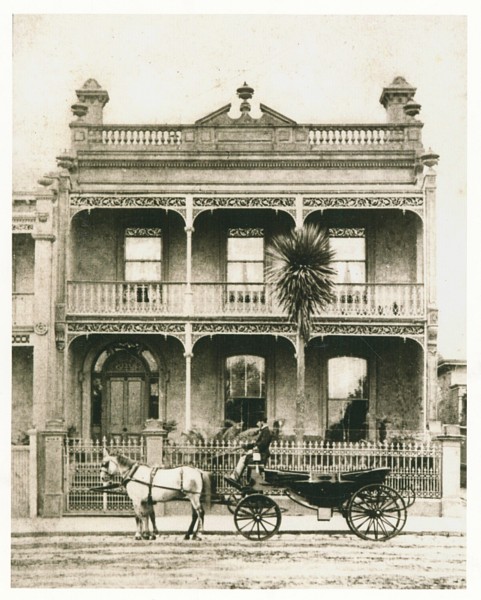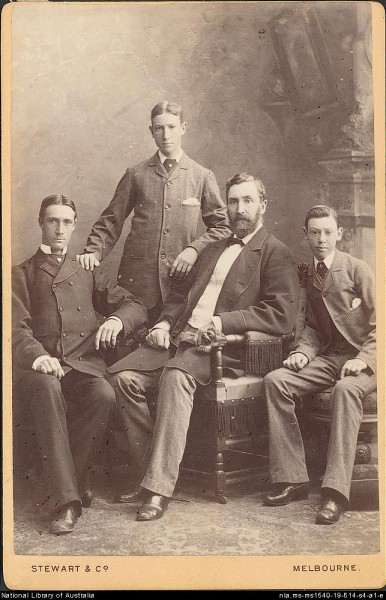That was Then, This is Now
If you stand on the corner of Powlett Street and Wellington Parade looking east, there’s the 7-Eleven store, the dry cleaner, a couple of cafes, the Il Duca restaurant and, at the end of the line, the Post Office, an unassuming, utilitarian modern building. It’s hard to believe that, in the latter days of the nineteenth century, we had instead a line of Victorian homes, designed to showcase the wealth of a city that was moving into its maturity as one of the great Victorian cities of the world.
But back to the Post Office. In 1873 Hugh Junor Browne bought the single storey house then on the site and employed architect F.M.White, best known for his design for the Old Law School building at Melbourne University, to make alterations. The house was to be expanded, with a second story added. Builder, J. Thomas of Kent Street, Richmond, undertook the work.
Born in Edinburgh, Hugh Junor Browne, then aged 23, had arrived in Melbourne in 1852 on the ship Sarah Bill to join the gold rush, seeking his fortune at Fryers Creek. With the money he made from gold, he set up a store at Forest Creek, which he sold to build a brick factory at Brunswick, but sold it after six months to return to England. There, in 1858, he met the 16 year old Elizabeth Alice Turner and eloped with her. They were to have eleven children, four daughters and seven sons.
In 1867, they returned to Melbourne, where Hugh bought an estate at Broadmeadows and set up the very profitable Australian Distillery Works on the banks of the Yarra close to Princes Bridge.
In 1874, Hugh and Alice moved into their new house at 14 Wellington Parade, East Melbourne, in order to have greater access to education for their children. It was now called Park House. Here, in July 1881, their eldest daughter Pattie became engaged to a young and penniless barrister named Alfred Deakin. Pattie and Alfred were married at Park House on 3 April, 1882. So distressed was her father that he refused to give her a dowry, fearing that, with the admittedly handsome, six feet tall Alfred, she might have a miserable life. He relented later, but left no portion of his estate to her in his will. Alfred Deakin went on to be Prime Minister of Australia for three terms and a dominant force in the early years of Federation.
In 1884, tragedy struck the family, when they lost two sons, William, aged 18 and Hugh, 20, in a yachting accident, along with their close friend, William Murray. On Saturday, 13 December, the three young men set out on their yacht, Iolanthe, planning to do some fishing in Port Phillip Bay, then to head to Frankston on the Sunday, before sailing home the following day.
They never returned. A week later, William’s body, minus the right arm, was washed up at Picnic Point, Sandringham.
On Christmas Day, there was another discovery. A group of friends, led by Mr. Coxsall, a local butcher, were shark hunting for sport off the Frankston Pier. At 1 am, a four metre shark swallowed their bait. The men hauled it up and opened the stomach, in which they found the lower part of a right arm, a coat with a meerschaum pipe attached, a pair of trousers with ten shillings and sixpence in the pocket and a vest with a gold watch attached by a silver chain. A brother, Thomas Browne, identified them as belonging to his brother Hugh.
The shark was taken to Melbourne and displayed for a day at Messrs. Hall’s stables in Swanston Street.
Both Hugh Junor Browne and Alice were Spiritualists and believed that ‘life and death include an in-between realm, where spirits were able to exist and communicate with the living.‘
When the boys had not returned on Tuesday, Hugh and Alice called in a ‘medical clairvoyant’, Mr George Spriggs, who came into the house unaware of the issue. According to Hugh Junor Browne’s account, Mr Spriggs immediately fell into a trance and said ‘Oh, I perceive it is all about the sea’ and proceeded to tell the grieving parents the story of their sons’ deaths. At the inquest following the discovery of William’s body, Hugh Browne attempted to explain ‘the exact manner in which his son’s death occurred as relayed to him by the young man’s spirit after its departure to the other world, but the coroner refused to receive that kind of evidence.’ (Geelong Advertiser, 24/12/1884 p.3). He was to write of this experience and the account greatly impressed another Spiritualist, Sir Arthur Conan Doyle.
In 1889, the family left East Melbourne and moved to a new house, Llanarth in Walsh Street, South Yarra. Hugh Junor Browne died on 3 December, 1905. Alice died in 1912. Park House became a boarding house under the management of a Miss Mitchell.
There are a few other indications of the wealth and status of that portion of Wellington Parade in the late nineteenth century: Rolyat and Virginia, now a medical clinic, are just across the lane. And further down, past the office blocks is the real treasure of the block, the elegant and much-loved
Elizabeth House. Park House was demolished in 1967 and replaced by a much larger office building, now our local Post Office.
This article first appeared in the Inner City News, March 2022


